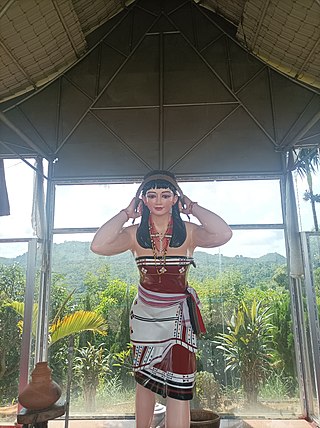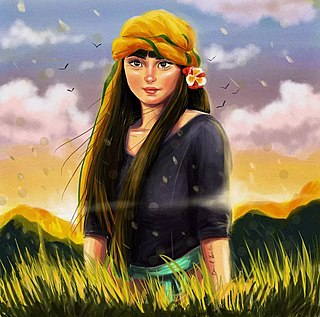
Meitei literature, also known as Manipuri literature, is literature written in the Meitei language of Manipur. An ancient institution of learning, the Luwang Nonghumsang, later known as the Pandit Loishang, collected sources of indigenous Meitei knowledge and philosophy until the 18th century. Writing by Meiteis is assumed to go back to the Kingdom of Kangleipak in the early 12th century. The Meitei script is a Brahmic abugida. It is known only from the Puya manuscripts discovered in the first half of the 20th century. Manuscripts of the 18th and 19th centuries were written using the Bengali alphabet. The existence of the Meitei script in the 15th-century hinges on the authenticity of an inscription dated to the reign of Senbi Kiyamba. The first printed Manipuri book, Manipurer Itihas, appeared in 1890 from the Baptist Mission Press, Calcutta. Though the kings of Manipur had established contact with the British from the middle of the eighteenth century onward the real impact of the contact came much later. Johnstone Middle English School, based on the western system of education, was started in 1885 at Imphal, and in 1891 Manipur lost its independence to the British. British domination facilitated the introduction of new systems in the civil, political and educational spheres, which hastened the process of modernization in Manipur, exposed as it was to new ideas and influences.

Imoinu or Emoinu is a goddess associated with household, hearth, family, fireplace, kitchen, wealth, peace and prosperity in Meitei mythology and religion of Ancient Kangleipak. She is frequently associated with Leimarel Sidabi. She is regarded as one of the incarnations or representations of goddess Leimarel Sidabi.

Leimarel Sidabi or Leimalel Sitapi is a goddess in Meitei mythology and the religion of Ancient Kangleipak. She is the highest female divinity in the Meitei pantheon. She is the goddess of earth, of nature and the household. She is revered as the mother of every living being in the universe.

Panthoibi, also known as Nongpok Leima, is a goddess associated with civilization, courage, fertility, handicraft, love, victory, warfare and wisdom in the mythology and religion of Ancient Kangleipak. She is a consort of the God Nongpok Ningthou. She is considered to be one of the divine incarnations of Leimarel Sidabi and is also identified as a form of Goddess Nongthang Leima. She is worshipped mainly by the Meitei people in Manipur, Assam, Tripura, Bangladesh and Myanmar.

Mount Koubru (Meeteilol:ꯀꯧꯕ꯭ꯔꯨ) also known as Mount Koupalu is one of the highest mountains in Manipur, India and the abode of the god Lainingthou Koubru and the goddess Kounu in Manipuri mythology. Sapormeina town lies below the peak. It is located in the Kangpokpi district of Manipur and is one of the most visited pilgrimage sites in Manipur.

In Meitei mythology and religion, Nongthang Leima is the goddess of seduction, thunder, and lightning. She was created by Atingkok to attract Haraba (Pakhangba). She mastered thunder and lightning in the chaos in the early world. She predicted the first rain. She limits the chaos and helps creation.

Kounu is a goddess in Meitei mythology and religion of ancient Kangleipak. She is a consort of the god Koupalu. She is the guardian of the northern direction. Kounu has two homes. Her main home is on Mount Kounu. Her other home is in Mount Koubru, which is where her husband Koupalu (Koubru) lives. She is worshipped with Koubru as the deities of the Khullakpa. Kounu and Koubru ruled ancient Manipur for a very long time after the reign of King Ningthou Puthiba.
Puya Meithaba, or Lairik Meithaba, refers to the annual commemoration of a legendary 18th-century scripture burning in post-colonial Manipur, or to the original libricide of Puya itself. There is no historical evidence that the libricide was planned, much less that it did happen. Nonetheless, the commemoration, organised by the Meitei National Front and others since 1979, has been a critical tool in the spread of Meitei nationalism and has mainstreamed a particular reconstruction of premodern Manipur, which has come to be uncritically reproduced even in academic publications.

Haoreima or Haoleima is a goddess of tragic love and separation in Meitei mythology and religion of Ancient Kangleipak. According to some legends, she was a woman from the hills, who was killed while arranging to meet her lover, and turned into a tortured spirit. She is regarded as an incarnation of Goddess Panthoibi. She is also identified with goddess Nongthang Leima.

Noinu Thumleima or Thumkhong Lairembi is the goddess of salt and salt wells in Meitei mythology and religion of ancient Manipur. She is a sister of the goddesses, Phouoibi (Phouleima), Ngaleima and Ereima (Ireima). People pray to her so there will be enough salt. Salt is an important part of the human diet.

Yumjao Leima or Yumjao Lairembi or Yumjao Lairemma is the mother goddess of house, household, royalty, rule and power in Meitei mythology and religion. She is designated as the all time ruling Queen Mother. Legend says she assumes a human form in white clothes and blesses kings. She is one of the divine incarnations of Leimarel Sidabi.

Leima Lainaotabi or Leinaotabi is a goddess in ancient Meitei mythology and religion. She is the youngest wife of God Thongalel of the underworld kingdom. Thongalel sent her to be the wife of Poireiton, her brother-in-law. Lainaotabi gave birth to a son with Poireiton. Her legend says she made the first clay pot. She was worshipped by the people of Ashangbam clan.

Thongak Lairembi, also known as Langol Lairemma, is a goddess in Meitei mythology and religion. She is the divine female personification of the death. She guards the door of the entrance to the underworld, which is the land of the death, ruled by her consort, Thongalen. Legend says she gets departed from her husband when Thongalel was lost in the battle between the gods of the underworld and those of the upper world, in the hands of Salailen Sidaba. The winner asked the goddess, who is the wife of the loser, to be the gatekeeper of the entrance gate to the underworld, and for Thongalel, he gave him Khamnung Kikoi Louonbi, in return.

Khamnung Kikoi Louonbi is a goddess in Meitei mythology and religion. She is the divine feminine personification of the death. She carries off the souls of people to the underworld when the time allotted to them to live had expired. If any soul is not willing to accompany her, then she will either serve it a false magical fruit to agree with her conducts or transform herself into the looks of a person, who is the dearest to the soul, especially that of mother, and persuade it. By any means, she will bring the souls of the dead people to the netherworld. She is the consort of Thongalel, the God of the death and the ruler of the underworld. She is said to be created from the very body of Salailen Sidaba, the Supreme Being.

Koujeng Leima is a goddess in Meitei mythology and religion. She is a wife of God Koupalu (Koubru). She is of tribal origin, but later worshipped by the Meiteis. She is one of the nine Laibenthous.

Khunu Leima or Khunureima (/khoo-noo-rei-ma) is the goddess of pigeons and doves in Meitei mythology and religion. She is a sister of goddesses Nganu Leima and Shapi Leima. Legend says that all three sisters married the same mortal man.

Nganu Leima or Nganureima (/ngaa-noo-rei-ma) is the goddess of ducks and other water birds in Meitei mythology and religion. She is a sister of goddesses Khunu Leima and Shapi Leima. Legend says that all three sisters married to the same mortal man.

Shapi Leima or Sapi Leima is the goddess of rodents in Meitei mythology and religion. She is a sister of goddesses Khunu Leima and Nganu Leima. Legend says that all three sisters married the same mortal man.

Ichum Lairembi or Echum Lairembi or Eechum Lairembi is a Lairembi (goddess) in Meitei mythology and religion of Ancient Kangleipak. Her major cult centre of worship is located in Khurkhul region, present day Manipur.

Women have significant roles in different elements of Meitei culture, including Meitei dances, Meitei festivals, Meitei folklore, Meitei folktales, Meitei literature, Meitei mythology, Meitei religion, etc.














